System Methodology Assignment On Inventory Tracking System
Question
Task:
For the purpose of this assignment, you are assumed to be one of the software consultants appointed to shoulder the system analysis responsibilities in, the project outlined in the case study.
You will plan and manage the project as well as investigate and document its system requirements. For your Assignment 1 submission, you will produce a report that discusses this project based on your understanding of it and the related investigation results through the tasks below.
Task 1:
Approaches to Systems Development
-
How would “Australian Labs” go about developing its information systems? (5 Marks)
-
Justify your choice of your selected approach to systems development. (5 Marks)
Task 2:
Systems Requirements
-
What are the primary functional requirements for the system in the case study? (10 Marks)
-
What are the non-functional requirements for the system in the case study? (5 Marks)
Task 3:
Project Cost Benefit Analysis
-
Discuss your Project Cost Benefit Analysis. (7.5 Marks)
-
Provide an excel spread sheet with details in a Project Cost Benefit Analysis. (7.5 Marks)
Task 4:
Project Schedule
-
Show a work breakdown structure and a project schedule as a Gantt Chart. Explain both of them and discuss how they relate to each other. (10 Marks)
-
Given the system goals, requirements, and scope as they are currently understood, is the project schedule reasonable? Why or why not? (10 Marks)
Task 5:
System Information Requirement Investigation Techniques
-
Who are the stakeholders involved? (5 Marks)
-
Explain your choice of the 3 most useful investigation techniques. (10 Marks)
-
Justify the usefulness of these 3 investigation techniques. (10 Marks)
Answer
Introduction
The system methodology assignment has been prepared for Australian Labs and includes the details of the inventory tracking system for the organization. The aim of this system methodology assignment is to describe the system methodology details for the development activities and to describe the requirements and estimations associated with the system (Dixit & Bhushan, 2019).
There are several phases that are involved in the system development lifecycle and it is necessary that the execution of all of these phases is done in an effective manner to achieve the aims of the project. The objectives of the project examined herein system methodology assignment is to streamline the inventory management system at Australian Labs by automating the existing workflows.
Approach to Systems Development
There are different approaches and methodologies that have been defined for carrying out the system development. The inventory tracking system that is to be developed shall be done using the agile scrum methodology (Kautz et al., 2015). This approach illustrated in this part of system methodology assignment has been selected as the preferred methodology for the system because it will enable the system to be flexible and Australian Labs will be able to incorporate the existing requirements and will also be able to make the changes in the future. The inventory tracking system is an automated system and the current workflows that are conducted in the organization are mostly paper-based (Kalyani & Mehta, 2019). This will be first of such systems that Australian Labs will implement. It is, therefore possible that the end-users of the system, such as the partner doctors and medical professionals along with the employees of the lab may not be clear on their expectations from the systems (Khalid et al., 2020). These requirements and expectations may be clarified as the system development lifecycle progresses. The traditional methodologies, such as the Waterfall model will not be able to meet these changing requirements. The agile method will be able to incorporate these changes in a smooth manner (Mahnic, 2015).
It would be necessary that the end-users get to access the system as it is developed to conduct the testing processes simultaneously with the development lifecycle. The end-users will give their comments at the end of every module or functionality development and this will enable the development team to make the changes in parallel with the development work (Lines & Ambler, 2018). This will lead to the avoidance of the major reworks at the implementation stage. This will also lead to potential cost-savings and will be possible only through the agile methods.
Systems Requirements
What are the Functional Requirements of the project examined in the system methodology assignment?
- The end-users of the inventory tracking system shall be able to securely login and logout from the system.
- The lab technicians shall be able to get access to the customer requests and the associated vials & details from the system.
- The customers to be able to track their requests on the system and must also be able to cancel or modify their requests (Pardo Calvache et al., 2019).
- The lab technicians to be provided with the status on the customer requests with the associated comments.
- The system data shall be stored at the back-end in the associated database which shall get updated with every new request or cancelling of an existing request.
- The customers and the system users shall be able to manage their account and profile on the system.
- The contact details of Australian Labs shall be present on the system with the information on the services and tests offered (Maximini, 2019).
- The user feedback forms on the system and shall allow the users to give their valuable comments.
Non-Functional Requirements
- The security of the user information will be supreme and the system shall provide the data and network security and privacy.
- The user expectations shall be met with the high usability of the system.
- System access to the users at any time and the availability of the system shall be assured.
- The system shall be easy to use and it shall also be easy to maintain.
- The system shall have portability and the access to the system shall be enabled at any platform (Pham, 2015).
Project Cost Benefit Analysis
The section of system methodology assignment covers the details of the project costs and the benefits. There will be several costs that will be associated with the inventory tracking system. The inventory tracking system will involve numerous tools, materials, and equipment that will be procured in the beginning and the one-time costs of $80,000.00 will be associated with it. The recurring cost of the system is calculated as $25,000 annually with the net benefits obtained as $40,000 annually. It is essential that the cost-benefit ratio is obtained and a discount factor of 10% is applied on the same to determine the benefits and overall summary (Rajasekaran, 2015). The total costs for the span of five-years are determined as $205000 and the total benefits for the same period are calculated as $225000. The cost benefit summary with the determination of net present value and internal rate of return is summarized in the table below within the system methodology assignment.
|
Fiscal Year |
||||||
|
0 |
1 |
2 |
3 |
4 |
5 |
|
|
Undiscounted Flows |
||||||
|
Costs |
-$80,000 |
-$25,000 |
-$25,000 |
-$25,000 |
-$25,000 |
-$25,000 |
|
Benefits |
$0 |
$45,000 |
$45,000 |
$45,000 |
$45,000 |
$45,000 |
|
Net Cash Flow |
-$80,000 |
$20,000 |
$20,000 |
$20,000 |
$20,000 |
$20,000 |
|
Discount Factors |
||||||
|
Discount Rate |
10.0% |
|||||
|
Base Year |
0 |
|||||
|
Year Index |
0 |
1 |
2 |
3 |
4 |
5 |
|
Discount Factor |
1.0000 |
0.9091 |
0.8264 |
0.7513 |
0.6830 |
0.6209 |
|
Discounted Flows |
||||||
|
Costs |
-$80,000 |
-$22,727 |
-$20,661 |
-$18,783 |
-$17,075 |
-$15,523 |
|
Benefits |
$0 |
$40,909 |
$37,190 |
$33,809 |
$30,736 |
$27,941 |
|
Net |
-$80,000 |
$18,182 |
$16,529 |
$15,026 |
$13,660 |
$12,418 |
|
Cumulative |
-$80,000 |
-$61,818 |
-$45,289 |
-$30,263 |
-$16,603 |
-$4,184 |
|
Net Present Value |
($4,184) |
|||||
|
Internal Rate of Return |
8% |
Table 1: Cost-Benefit Analysis
Project Schedule
The costs of the project are estimated above within this system methodology assignment. It is essential that the schedule is also determined accurately so that the project management can be effectively done. The inventory tracking system that is being developed will be developed using the agile scrum methodology and there will be sprints involved in the development phase. The overall management of the project will be done using the PMBoK methodology (Sharma & Bali, 2018).
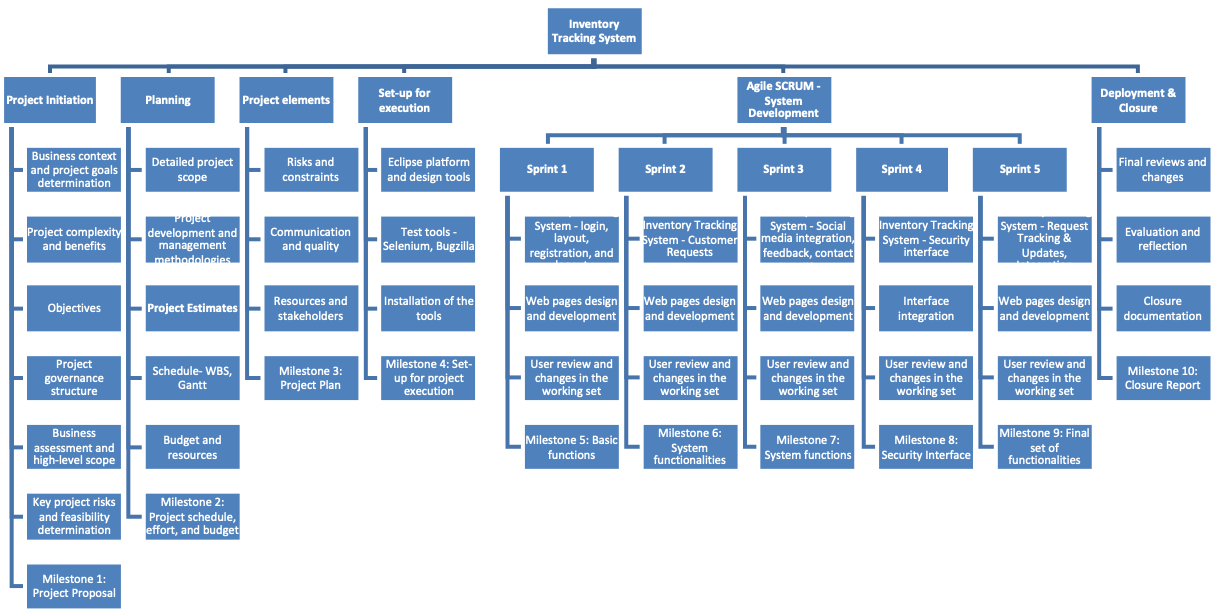
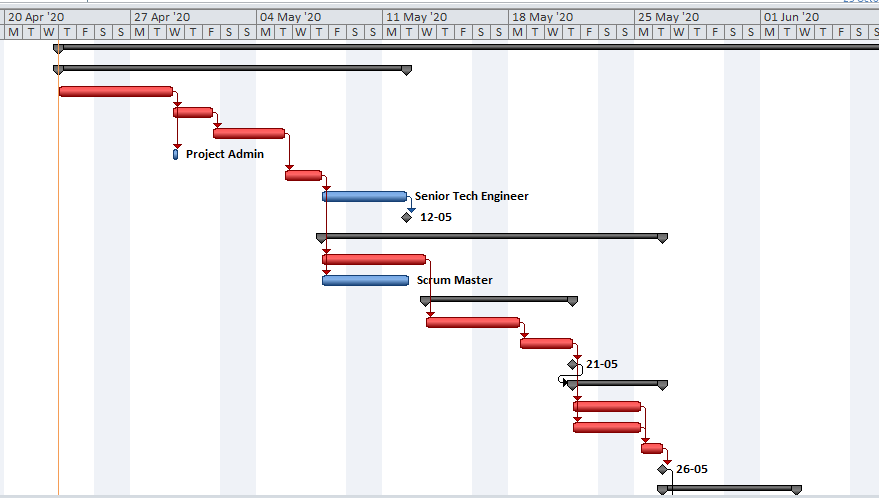
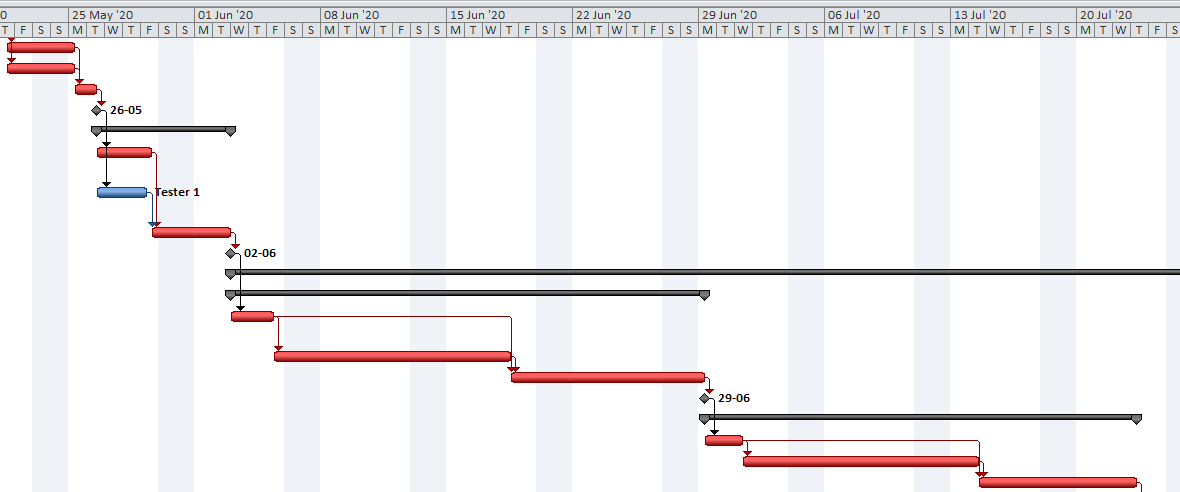
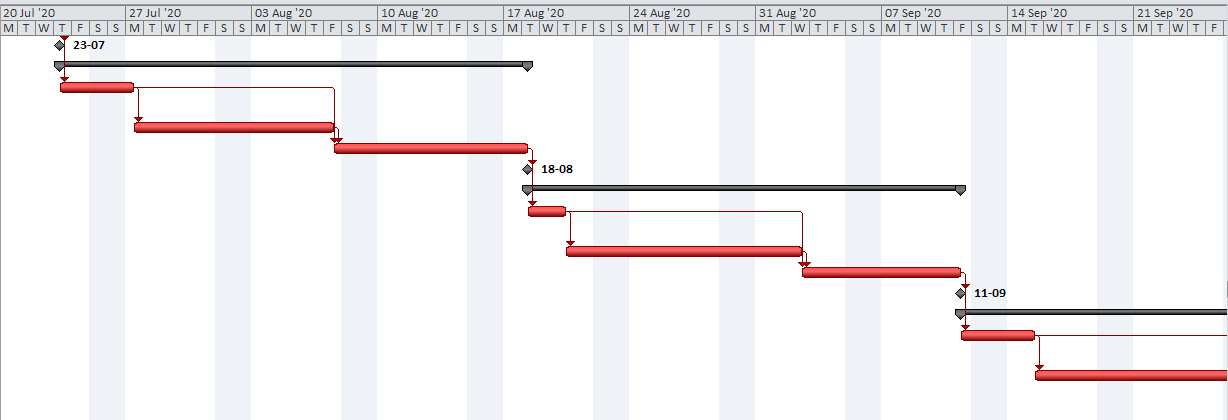
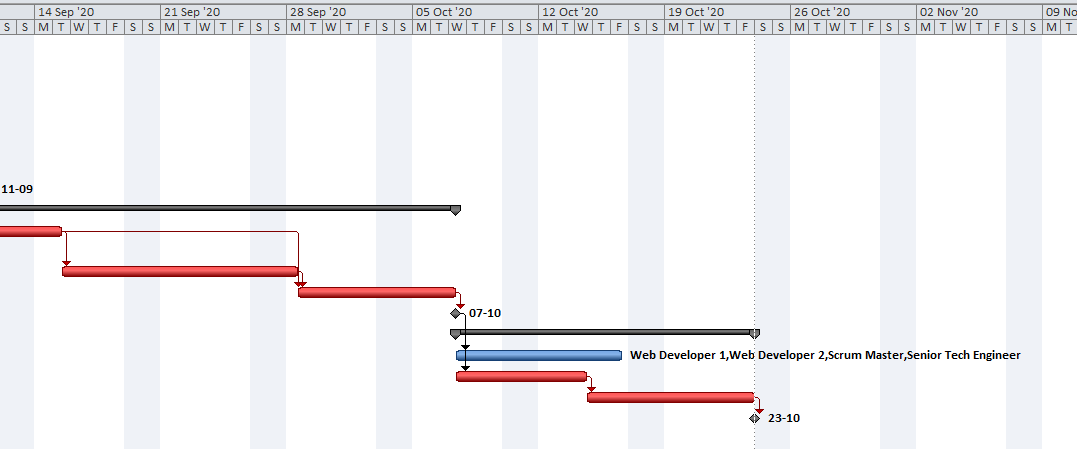
The work breakdown structure of the project is included below in the system methodology assignment and breaks down the project activities in different levels.
The use of the MS Project tool is done to determine the timeline of the project. The application of the tool has been done to calculate the duration for all the project activities and the Gantt chart of the project showcases the same. The inventory tracking system that is to be developed shall be done using the agile scrum methodology (Schwaber, 2015). This approach has been selected as the preferred methodology for the system in the case of system methodology assignment because it will enable the system to be flexible and Australian Labs will be able to incorporate the existing requirements and will also be able to make the changes in the future.
System Information Requirement Investigation Techniques
Australian Labs is the sponsor of the project and it is the primary stakeholder of the project as well. The end-users of the system will be the employees of Australian Labs and the clients placing their requests for the tests. These will be the stakeholders that will give their feedback on the system developed. The materials to develop the system will be procured from the vendors and these will make for the significant project stakeholders. The project management and team will be the internal stakeholders involved.
The requirements for the information system will be collected using three main investigation techniques as discussed in the system methodology assignment. These will be interviews, surveys, and observations (Turley, 2018).
The individual expectations and requirements of the users will vary from one another. The use of the interviews technique will provide the ability to understand the individual user expectations. The interviews will be conducted with some of the Australian Labs employees, customers, and the clients of the lab. The interview techniques will provide clarity of perspective to the project team.
The wider audience will be targeted using the surveys as the technique for requirements investigation. This will provide the ability to reach to more number of people and collect enhanced information on the inventory tracking system.
There is manual system that is currently followed at Australian Labs. The current system shall be understood well before the automated system is developed. The use of the observations technique will be done for this purpose. This will provide an understanding of the gaps in the manual process and the improvements required.
Reflections and Conclusions
The overall discussion done in the system methodology assignment could be concluded by saying that I was able to learn about the agile scrum methodology and could carry out the requirements identification and investigation properly in the project. This was one of the major achievements as the entire project lifecycle depends upon the clarity of the requirements and the plans that are developed in the project. The project costs and the schedule were the major constraints that I could find.
The inventory tracking system shall be developed using the agile scrum methodology and it shall pay equal attention to the functional and the non-functional aspects. The project examined in the segments of system methodology assignment will start on 23rd April 2020 and it will end on 23rd October 2020. Interviews, surveys, and observations shall be the three major information investigation techniques that shall be used.
References
Dixit, R., & Bhushan, B. (2019). Scrum: An Agile Software Development Process and Metrics. Journal on Today’s Ideas - Tomorrow’s Technologies, 7(1). https://doi.org/10.15415/jotitt.2019.71005
Kalyani, D., & Mehta, D. (2019). Study of Agile Scrum and Alikeness of Scrum Tools. System methodology assignment International Journal of Computer Applications, 178(43), 21–28. https://doi.org/10.5120/ijca2019919318
Kautz, K., Johanson, T. H., & Uldahl, A. (2015). The Perceived Impact of the Agile Development and Project Management Method Scrum on Information Systems and Software Development Productivity. Australasian Journal of Information Systems, 18(3). https://doi.org/10.3127/ajis.v18i3.1095
Khalid, A., Butt, S. A., Jamal, T., & Gochhait, S. (2020). Agile Scrum Issues at Large-Scale Distributed Projects. International Journal of Software Innovation, 8(2), 85–94. https://doi.org/10.4018/ijsi.2020040106
Lines, M., & Ambler, S. W. (2018). Introduction to disciplined agile delivery?: a small agile team’s journey from Scrum to DevOps. Discipline Agile Consortium.
Mahnic, V. (2015). A Capstone Course on Agile Software Development Using Scrum. IEEE Transactions on Education, 55(1), 99–106. https://doi.org/10.1109/te.2011.2142311
Maximini, D. (2019). SCRUM CULTURE?: introducing agile methods in organizations. Springer.
Pardo Calvache, C. J., Chilito Gomez, P. R., Viveros Meneses, D. E., & Pino Correa, F. J. (2019). system methodology assignment Scrum+: A scaled Scrum for the agile global software development project management with multiple models. Revista Facultad de Ingeniería Universidad de Antioquia. https://doi.org/10.17533//udea.redin.20190519
Pham, A. T. (2015). Business-driven IT-wide agile (scrum) and Kanban (lean) implementation?: an action guide for business and it leaders. Crc Press.
Rajasekaran, V. (2015). Issues in Scrum Agile Development Principles and Practices in software development. Indian Journal of Science and Technology, 8(35). https://doi.org/10.17485/ijst/2015/v8i35/79037
Schwaber, K. (2015). Agile project management with scrum. Microsoft.
Sharma, A., & Bali, M. (2018). Comparative Study on Software Development Methods: Agile vs Scrum. International Journal of Emerging Research in Management and Technology, 6(6), 165. system methodology assignment https://doi.org/10.23956/ijermt.v6i6.263
Turley, F. (2018). Agile Scrum Foundation.












